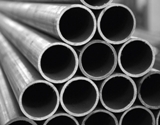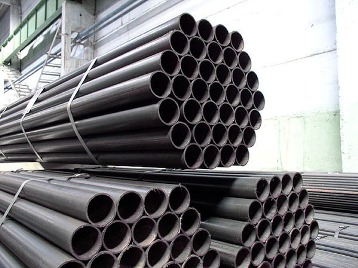Rolling stock: steel pipes
 Steel pipes are widely used in the production of various structures: construction of pipelines, production of parts for boilers and heating bodies, body parts, frame structures, racks, etc. Steel pipes are used for laying wires and cables during electrical works.
Steel pipes are widely used in the production of various structures: construction of pipelines, production of parts for boilers and heating bodies, body parts, frame structures, racks, etc. Steel pipes are used for laying wires and cables during electrical works.
The choice of a specific type of pipes is due to their purpose and the way the structure works. All pipes can be conditionally divided into two types: general purpose and special.
The most commonly used general purpose pipes are produced in the following types:
1. Small pipes in accordance with GOST 14162-79 (capillary). Outer diameter D 0.32 … 4.8 mm, wall thickness s 0.1 … 1.6 mm, pipe length L 0.3 … 7.0 m. Capillary tubes are produced in several groups:
1.1 "A" — standardization in the production of pipes with chemical composition and physical-mechanical properties;
1.2 "B" — only by chemical composition;
1.3 «B» — only for physical-mechanical properties.
2.Precision (high precision): hot-rolled in accordance with GOST 9567-75 (D = 25 ... 325 mm, s = 2.5 ... 50 mm, L = 4 ... 12 m), calibrated in accordance with GOST 9567-75 (D = 5. .. 710 mm, s = 0.2 ... 32 mm, L = 1 ... 11.5 m). Regarding the thickness of the walls, they can be particularly thin-walled (D / s more than 40), thin-walled (D / s more than 12.5 and less than 40), thick-walled (D / s more than 6 and more -a little more than 12), especially thick-walled (D / s less than 6). Technical conditions for the production of precision pipes by cold rolling without heating are regulated by GOST 8733-74, hot-rolled - in accordance with GOST 8731-87 (see below).
3. Extremely thin-walled seamless pipes made of corrosion-resistant steel in accordance with GOST 10498-82 (D = 4 ... 120 mm, s = 0.12 ... 1.0 mm, L = 0.5 ... 8 m). Pipes can be produced with high and very high precision. Steel brands for the production of such pipes are as follows: 09X18H10T, 06X18H10T, 08X18H10T (by agreement with the customer — there may be others).
4. Seamless cold-worked pipes in accordance with GOST 8734-75 (D = 5 ... 250 mm, s = 0.3 ... 24 mm, L = 1.5 ... 12.5 m). Regarding the thickness of the walls, they can be especially thin-walled, thin-walled, thick-walled, especially thick-walled. The pipe material is specified in GOST 8733-74.
5. Electrically welded cold-treated pipes according to GOST 10707-80 (D = 5 ... 110 mm, s = 0.5 ... 5 mm, L = 1.5 ... 9 m). Made of carbon (unalloyed) steel. Quality groups of such pipes practically correspond to types «A», «B», «B», «D» according to GOST 8731-87.In addition, the height of the residual welding melt on pipes is adjusted (in three categories, the last category is without bumps).
6. Electrically welded pipes with a longitudinal seam according to GOST10704-91 (D = 8 ... 1620 mm, s = 1 ... 16 mm, L = 2 ... 10 m). Production is regulated by the technical conditions described in GOST 10705-80 and GOST 10706-76. Quality categories are similar to «A», «B», «C», «D» in accordance with GOST 8731-87. They can be produced with increased accuracy. Pipes are widely used in the production of highway pipelines and body parts. The test pressure for pipes of this type is up to 20MPa.
Steel pipes
7. Seamless hot-deformed pipes made of corrosion-resistant steel in accordance with GOST 9940-81 (D = 57 ... 325 mm, s = 3.5 ... 32 mm, L = 1.5 ... 10 m). Manufactured with conventional, high precision. On request, the pipe material can be tested against intergranular corrosion.
8. Seamless cold and heat-deformed pipes made of corrosion-resistant steel in accordance with GOST9941-81 (D = 5 ... 273 mm, s = 0.2 ... 22 mm, L = 1.5 ... 12.5 m). They are made of ordinary, high and high precision steels 04X18H10, 08X17T, 08X13, 12X13, 12X17, 15X25T, 08X20H14S2, 10X17H13M2T, 12X18H10T, 08X18H9, 08X22H6T, 08XH2 8MDT and others.
9. Water and gas pipelines welded in accordance with GOST 3262-75 (D = 10.2 ... 165 mm, s = 1.8 ... 5.5 mm, L = 4 ... 12 m). They are produced in galvanized and non-galvanized, with and without threads (cylindrical, made by cutting or scraping). The thread is applied after galvanizing the surface of the pipe.Pipes are widely used for the production of pipe elements for heating systems, water and gas structures. When ordering pipes of this type, it is necessary to take into account that the marking determines the nominal opening of the pipes, not the outer diameter.
10. Seamless pipes with high pressure according to GOST 11017-80 (D = 6 ... 13mm, L = 0.5m). They are made of carbon steel, most commonly used for diesel fuel lines.
The order must specify the grade of steel and the standard governing the properties of the steel for the production of pipes. The most important assessment of the applicability of pipes to certain working conditions are the quality indicators that determine the technology for the production of rolled products. According to GOST 8733-74, there are five quality groups:
1. "B" — regulation of the chemical composition during production.
2. "B" — regulation of the chemical composition and physical-mechanical properties.
3. «G» — physical and mechanical properties are checked on heat-treated samples, while also monitoring the chemical composition.
4. «D» — physical-mechanical properties and chemical composition are not regulated, but hydraulic tests are performed.
5. "E" — pipe material after special heat treatment.
According to GOST 8731-87, there are the following similar quality groups:
1. "A" — with regulation of physical and mechanical properties only (steel for the production of pipes in accordance with GOST 380-88).
2. «B»-control of chemical composition only (steel according to GOST 380-88, GOST 1050-88, GOST 4543-71, GOST 19281-89).
3. "B" — regulation of both the chemical composition and the physico-mechanical properties.
4. «G» — control of the chemical composition and physico-mechanical properties on heat-treated samples.
5.«D» — according to hydrotesting pressure.
The quality group is specified together with the steel brand when ordering the pipe assortment.
Cold-formed tubes have higher accuracy and surface finish than hot-formed tubes. However, their use is limited by the impossibility of producing pipes with a large diameter in this way and by the requirements of standards for the production of a certain type of product. Welded pipes are subjected to heat treatment to remove residual stresses, as well as non-destructive testing of the weld. Corrosion-resistant pipes are indispensable for use in aggressive environments.
The manufacture of special pipes is governed by the manufacturer's specifications.
Pipes can be supplied with measured, non-measurable length (in one batch — pipes of different, unregulated lengths; as a rule, the number of such pipes in a batch is no more than 10%) and lengths that are multiples of the measured length. Small diameter pipes can be supplied in coils. At the customer's request, additional production requirements can be specified (method of melting steel for pipes, accuracy requirements, additional hardening, heat treatment, hydro- and pneumatic tests, anti-corrosion coating and others).
A lot of pipe delivered to the customer is marked either directly on the pipe body or on an attached label. The marking contains information about the standard size of the pipes, heat number of steel and grade of steel, manufacturer and other data.
All batches of pipes are accompanied by a quality certificate that regulates the chemical composition, physical and mechanical properties of the pipes and additional delivery conditions.The quality certificate confirms the conformity of the goods with the requirements of GOST, the technical specifications of the manufacturer and the requirements of the user.

